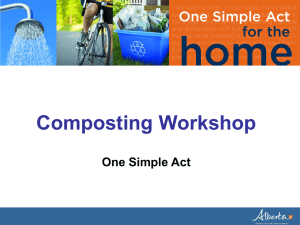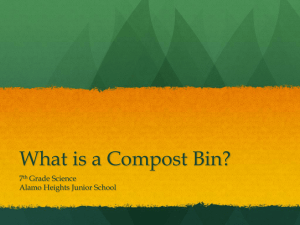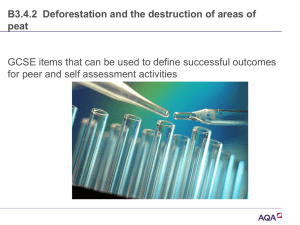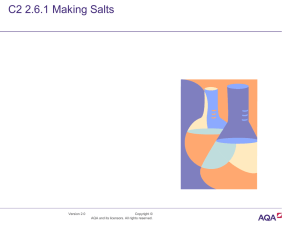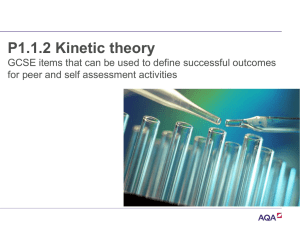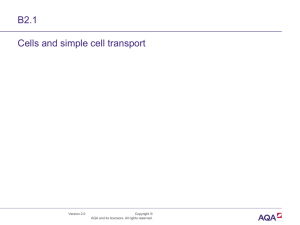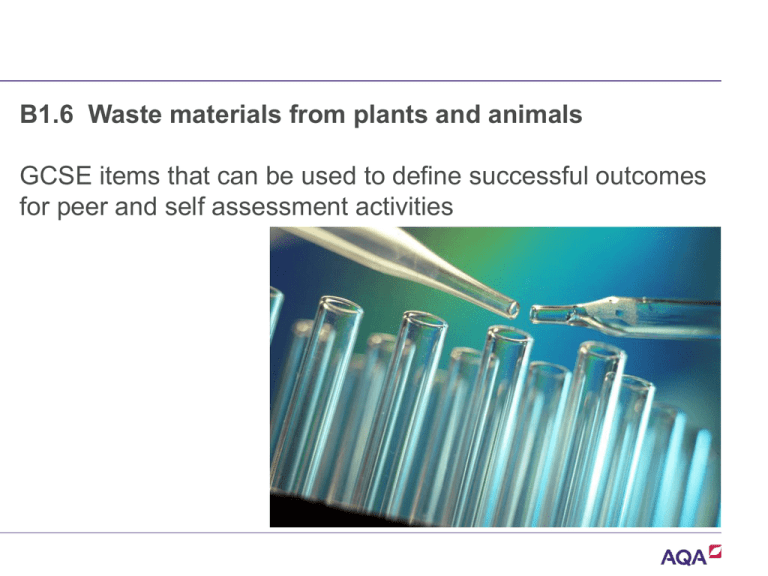
B1.6 Waste materials from plants and animals
GCSE items that can be used to define successful outcomes
for peer and self assessment activities
•
Assessment of practical work
Using Exam pro items to support successful outcomes
Learners will be able to test their progress against learning
outcomes using questions taken from past AQA GCSE
examinations.
Version 2.0
Copyright © AQA and its
licensors. All rights reserved.
•
B1.6 Waste materials from plants and animals June 2012 BL1FC
Garden waste can be recycled.
One way of recycling garden waste is to use a compost bin.
The diagram shows two types of compost bin.
Each bin can contain the same amount of waste.
Version 2.0
Copyright © AQA and its
licensors. All rights reserved.
•
B1.6 Waste materials from plants and animals June 2012 BL1FC
Information about the compost bins is given below.
Fixed compost bin
• Compost can be taken out after two years.
• The bin costs about £40.
• The bin takes up an area of 1 square metres.
Tumbler compost bin
The bin is turned twice a day using the handle.
Six weeks later compost can be taken out.
The bin costs about £80.
The bin takes up an area of 2 square metres.
Version 2.0
Copyright © AQA and its
licensors. All rights reserved.
•
B1.6 Waste materials from plants and animals June 2012 BL1FC
A gardener is buying a compost bin.
(a) (i) Give one advantage to the gardener of buying a tumbler compost
bin and not a fixed compost bin.
....................................................................................................................
...........
(1 mark)
(a) (ii) Give two advantages to the gardener of buying a fixed compost
bin and not a tumbler compost bin.
1………………………………..
2 …………………………………
(2 marks)
Version 2.0
Copyright © AQA and its
licensors. All rights reserved.
•
B1.6 Waste materials from plants and animals June 2012 BL1FC
(b) The same amounts of waste were added to the two types of bin.
The graph shows the temperature in the bins in the first six weeks after
the waste was added.
Version 2.0
Copyright © AQA and its
licensors. All rights reserved.
•
B1.6 Waste materials from plants and animals June 2012 BL1FC
(b) (i) Give two differences between the results for the tumbler compost
bin
and the fixed compost bin.
1……………………
2 ............................
(2 marks)
(b) (ii) Complete the sentences.
The waste is converted into compost by organisms
called ............................................................. .
The conversion of waste into compost works best in warm, moist
and .........................................................conditions.
(2 marks)
b) (iii) There was a big difference in the final temperatures in the two
bins.
Suggest an explanation for this temperature difference.
.................................................................................................
(2 marks)
Version 2.0
Copyright © AQA and its
licensors. All rights reserved.
Mark scheme
• B1.6 Waste materials from plants and animals June 2012
Mark Scheme
Version 2.0
Copyright © AQA and its
licensors. All rights reserved.
Mark scheme
Version 2.0
Copyright © AQA and its
licensors. All rights reserved.
•
B1.6 Waste materials from plants and animals June 2012 BL1HP
The diagram shows part of a carbon cycle in a habitat.
(a) Name the processes shown by arrows X and Y.
X .....................................................................
Y .....................................................................
(2 marks)
Version 2.0
Copyright © AQA and its
licensors. All rights reserved.
•
B1.6 Waste materials from plants and animals June 2012 BL1HP
(b) Describe the part played by algae in this carbon cycle.
....................................................................................................
....................................................................................................
......................................
........................................................................................................
...............
(3 marks)
(c) In tropical rainforests process X is much faster than in most
other habitats. Suggest why
………………………………………………………………………
…………………………………
………………………………………………………………………
…………………………………
(2 marks)
Version 2.0
Copyright © AQA and its
licensors. All rights reserved.
Mark scheme
Version 2.0
Copyright © AQA and its
licensors. All rights reserved.

